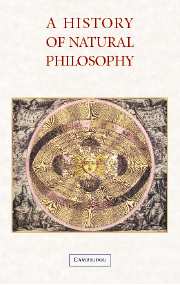Book contents
- Frontmatter
- Contents
- Preface
- 1 Ancient Egypt to Plato
- 2 Aristotle (384–322 BC)
- 3 Late Antiquity
- 4 Islam and the Eastward Shift of Aristotelian Natural Philosophy
- 5 Natural Philosophy before the Latin Translations
- 6 Translations in the Twelfth and Thirteenth Centuries
- 7 Natural Philosophy after the Translations: Its Role and Place in the Late Middle Ages
- 8 The Form and Content of Late Medieval Natural Philosophy
- 9 The Relations between Natural Philosophy and Theology
- 10 The Transformation of Medieval Natural Philosophy from the Early Modern Period to the End of the Nineteenth Century
- Conclusion
- Bibliography
- Index
8 - The Form and Content of Late Medieval Natural Philosophy
Published online by Cambridge University Press: 05 June 2012
- Frontmatter
- Contents
- Preface
- 1 Ancient Egypt to Plato
- 2 Aristotle (384–322 BC)
- 3 Late Antiquity
- 4 Islam and the Eastward Shift of Aristotelian Natural Philosophy
- 5 Natural Philosophy before the Latin Translations
- 6 Translations in the Twelfth and Thirteenth Centuries
- 7 Natural Philosophy after the Translations: Its Role and Place in the Late Middle Ages
- 8 The Form and Content of Late Medieval Natural Philosophy
- 9 The Relations between Natural Philosophy and Theology
- 10 The Transformation of Medieval Natural Philosophy from the Early Modern Period to the End of the Nineteenth Century
- Conclusion
- Bibliography
- Index
Summary
To understand the substantive character of natural philosophy, it is essential to describe the kinds of literature in which medieval natural philosophers expressed their thoughts. In Chapter 7, I mentioned the two most basic forms of scholastic literature: (1) the commentary on a text and (2) the questions format in which the author, or commentator, formulates a series of questions on Aristotle's text, posing the questions sequentially in the order of the text. Examples from both of these types will illustrate the most fundamental methods of conveying natural philosophy to a broad audience.
Textual Commentaries on the Works of Aristotle
In the preceding chapter, I distinguished four varieties of textual commentaries. Because the first two methods were used primarily for teaching and conveyed little of the commentator's opinions, I shall illustrate only the third and fourth types. The third type was that in which the commentator separated his commentary from the text on which he was commenting. This could take two forms, the first of which involved a section-by-section sequential commentary on the text, while the second was a paraphrase of Aristotle's text.
The section-by-section sequential commentary was probably the most popular and probably the easiest to follow. In this method, the commentator cited a section of Aristotle's text followed by his commentary on that passage, a technique that derived from Averroes, the great twelfth-century Islamic commentator, who quoted a section of Aristotle's text followed by comments, in which he explained Aristotle's meaning and intent.
- Type
- Chapter
- Information
- A History of Natural PhilosophyFrom the Ancient World to the Nineteenth Century, pp. 179 - 238Publisher: Cambridge University PressPrint publication year: 2007



